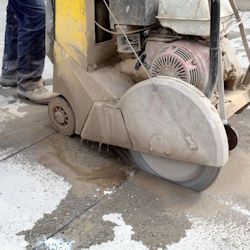Wet Methods
- Cutting: Wet cutting is the most effective method for controlling silica dust generated during sawing because it controls the exposure at its source. Wet dust is less able to become or remain airborne. Wet masonry saw operators' exposures usually well below 0.1 mg/m3.st stationary saws come equipped with a water basin that typically holds several gallons of water and a pump for recycling water for wet cutting. Handheld saws spray water that is held in separate containers.
- Drilling: Wet drilling systems pump water through the drill stem to prevent dust from being released into the air. The drill operator controls the flow using a control valve. Some drills are equipped with a flow meter.
- Hammering: Wet methods are generally not appropriate for use with electric rotary hammers; however, pneumatic drills can be used for wet drilling and some come equipped with water-feed capability. The best way to control silica dust when using a jackhammer is with wet methods, where water is constantly sprayed to reduce the amount of dust that gets into the air. Wetting the surface with a spray or mist of water at the point where the jackhammer's tip strikes the surface material helps reduce the amount of airborne dust.
- Grinding: Wet grinding is highly effective in reducing silica exposures. Water provides excellent dust control during tasks involving abrasive action on concrete. When applied at the point where dust is generated, water wets the dust particles before they can become airborne. Wet methods consistently keep employee exposures below OSHA limits.
Knowledge Check Choose the best answer for the question.
3-3. Vacuum dust collection systems for _____ include a shroud, hose, filters, and a vacuum to pull air through the shroud.
You forgot to answer the question!

